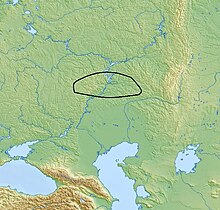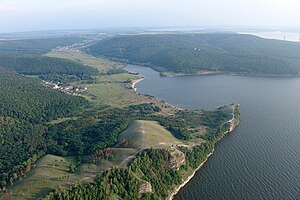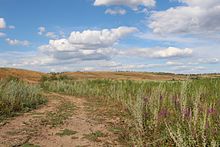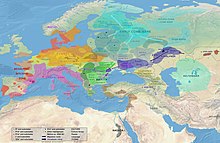52°44′29″N 49°33′05″E / 52.741254°N 49.551376°E / 52.741254; 49.551376
 | |
| Geographical range | Europe, Russia |
|---|---|
| Period | Eneolithic |
| Dates | c. 4900–3500 BCE |
| Preceded by | Samara culture |
| Followed by | Yamna culture |
| Part of a series on |
| Indo-European topics |
|---|
 |
Languages
|
| Philology |
Origins
|
|
Archaeology
Pontic Steppe Caucasus East Asia Eastern Europe Northern Europe Pontic Steppe Northern/Eastern Steppe Europe
South Asia Steppe Europe Caucasus India |
|
Peoples and societies
Indo-Aryans Iranians East Asia Europe East Asia Europe Indo-Aryan Iranian |
Religion and mythology
Others
|
Indo-European studies
|
The Khvalynsk culture is a Middle Copper Age Eneolithic culture (c. 4,900 – 3,500 BC) of the middle Volga region. It takes its name from Khvalynsk in Saratov Oblast. It was preceded by the Early Eneolithic Samara culture.
Dating
A number of calibrated C-14 readings obtained from material in the graves of the type site date the culture certainly to the approximate window, 5,000–4,500 BCE. This material is from Khvalynsk I, or Early Khvalynsk. Khvalynsk II, or Late Khvalynsk, is Late Eneolithic. Asko Parpola regards Khvalynsk culture to be c. 5,000 to 3,800 BCE.
Nina Morgunova regards Khvalynsk I as Early Eneolithic, contemporary with the second stage of Samara culture called Ivanovka and Toksky stage, which pottery was influenced by Khvalynsk culture, as calibrated period of this second stage of Samara culture is 4,850–3,640 BCE. Marija Gimbutas, however, believed Samara was earlier and placed Khvalynsk I in the Developed Eneolithic.
Not enough Samara culture dates and sites exist to settle the question. After c. 4,500 BCE, Khvalynsk culture united the lower and middle Volga sites keeping domesticated sheep, goats, cattle, and maybe horses.
Sites

The Khvalynsk type site is a cemetery, 30 m by 26 m, containing about 158 skeletons, mainly in single graves, but some two to five together. They were buried on their backs with knees contracted. Twelve of the graves were covered with stone cairns. Sacrificial areas were found similar to those at Samara, containing horse, cattle and sheep remains.
An individual grave was found in 1929 at Krivoluchie with grave goods and the remains placed on ochre, face up, knees contracted.
Artifacts
Khvalynsk evidences the further development of the kurgan. It began in the Samara with individual graves or small groups sometimes under stone. In the Khvalynsk culture one finds group graves, which can only be communal on some basis, whether familial or local or both is not clear. With the advent of better methods of recovering ancient DNA, perhaps someday it will be.
Although there are disparities in the wealth of the grave goods, there seems to be no special marker for the chief. This deficit does not exclude the possibility of a chief. In the later kurgans, one finds that the kurgan is exclusively reserved for a chief and his retinue, with ordinary people excluded.
This development suggests a growing disparity of wealth, which in turn implies a growth in the wealth of the whole community and an increase in population. The explosion of the kurgan culture out of its western steppe homeland must be associated with an expansion of population. The causes of this success and expansion remain obscure.
We do know that metal was available both in the Caucasus and in the southern Urals. The Khvalynsk graves included metal rings and spiral metal rings. However, there is no indication of any use beyond ornamental. The quality of stone weapons and implements reaches a high point. The Krivoluchie grave, which Gimbutas viewed as that of a chief, contained a long flint dagger and tanged arrowheads, all carefully retouched on both faces. In addition there is a porphyry axe-head with lugs and a haft hole. These artifacts are of types that not too long after appeared in metal.


There is also plenty of evidence of personal jewelry: beads of shell, stone and animal teeth, bracelets of stone or bone, pendants of boar tusk. The animals whose teeth came to decorate the putative Indo-Europeans are boar, bear, wolf, deer and others. Some of these teeth must have been difficult to acquire, a labor perhaps that led to a value being placed upon them. Whether they were money is not known.
The hard goods leave no record of any great richness. There is some evidence that wealth may have consisted of perishable goods. In fact, in many similar cultures of later times, wealth was reckoned in livestock. A recent study of the surface of the pottery (also of many cultures), which recorded contact with perishable material while the clay was wet, indicates contact with cords and embroidered woven cloth, which the investigators suggest were used to decorate the pot.
Physical type
Early examination of physical remains of the Khvalynsk people determined that they were Caucasoid. A similar physical type prevails among the Sredny Stog culture and the Yamnaya culture, whose peoples were powerfully built. Khvalynsk people were however not as powerfully built as the Sredny Stog and Yamnaya. The people of the Dnieper-Donets culture further west on the other hand, were even more powerfully built than the Yamnaya.
Genetics

Recent genetic studies have shown that males of the Khvalynsk culture carried primarily the paternal haplogroup R1b, although a few samples of R1a, I2a2, Q1a and J have been detected. They belonged to the Western Steppe Herder (WSH) cluster, which is a mixture of Eastern Hunter-Gatherer (EHG) and Caucasian Hunter-Gatherer (CHG) ancestry. This admixture appears to have happened on the eastern Pontic–Caspian steppe starting around 5,000 BC.
Mathieson et al. (2015, 2018) found in three Eneolithic males buried near Khvalynsk between 5,200 BC and 4,000 BC the Y-haplogroups R1b1a and R1a1, and the mt-haplogroups H2a1, U5a1i, and Q1a and a subclade of U4.
A male from the contemporary Sredny Stog culture was found to have 80% WSH ancestry of a similar type to the Khvalynsk people, and 20% Early European Farmer (EEF) ancestry. Among the later Yamnaya culture, males carry exclusively R1b and I2. A similar pattern is observable among males of the earlier Dnieper-Donets culture, who carried only R and I and whose ancestry was exclusively EHG with Western Hunter-Gatherer (WHG) admixture. The presence of EEF and CHG mtDNA and exclusively EHG and WHG Y-DNA among the Yamnaya and related WSHs suggest that EEF and CHG admixture among them was the result of mixing between EHG and WHG males, and EEF and CHG females. This suggests that the leading clans among the Yamnaya were of EHG paternal origin. According to David W. Anthony, this implies that the Indo-European languages were the result of "a dominant language spoken by EHGs that absorbed Caucasus-like elements in phonology, morphology, and lexicon" (spoken by CHGs) Other studies have suggested that the Indo-European language family may have originated not in Eastern Europe, but among West Asian (CHG-like) populations south of the Caucasus.
Notes
- /xvɑːˈlɪnsk, kvɑː-/; Russian: Хвалынская культура, pronounced [xvɐˈlɨnskəjə kʊlʲˈturə]
- "assive broad-faced proto-Europoid type is a trait of post-Mariupol’ cultures, Sredniy Stog, as well as the Pit-grave culture of the Dnieper’s left bank, the Donets, and Don. The features of this type are somewhat moderated in the western part of the steppe... All the anthropological types of the Pit-grave culture population have indigenous roots... The heir of the Neolithic Dnieper-Donets and Sredniy Stog cultures was the Pit-grave culture. Its population possessed distinct Europoid features, was tall, with massive skulls. The second component were the descendants of those buried in the Eneolithic cemetery of Khvalynsk. They are less robust."
References
- Mallory, J.P. "Khvalynsk Culture". In Mallory & Adams (1997), p. 328.
- Mallory, J.P. "Samara Culture". In Mallory & Adams (1997), p. 498.
- Parpola, Asko, 2012. "Formation of the Indo-European and Uralic (Finno-Ugric) language families in the light of archaeology: Revised and integrated 'total' correlations", in Linguistic Map of Prehistoric North Europe, Helsinki, p. 122.
- Morgunova, Nina L., 2015. "Pottery from the Volga area in the Samara and South Urals region from Eneolithic to Early Bronze Age", in Documenta Praehistorica XLII (2015), pp. 311, 315, and Table 2. .
- Morgunova, Nina L., 2015. "Pottery from the Volga area in the Samara and South Urals region from Eneolithic to Early Bronze Age", in Documenta Praehistorica XLII (2015), p. 315.
- Anthony 2019a, p. 13.
- Kuzmina 2007, pp. 383–384.
- Anthony 2019a, pp. 10–13.
- Mathieson et al. 2015.
- Mathieson et al. 2018.
- Anthony 2019b, p. 36.
- Anthony 2019a, pp. 13–19.
- Lazaridis, Iosif; Alpaslan-Roodenberg, Songül; Acar, Ayşe; Açıkkol, Ayşen; Agelarakis, Anagnostis; Aghikyan, Levon; Akyüz, Uğur; Andreeva, Desislava; Andrijašević, Gojko; Antonović, Dragana; Armit, Ian; Atmaca, Alper; Avetisyan, Pavel; Aytek, Ahmet İhsan; Bacvarov, Krum (26 August 2022). "The genetic history of the Southern Arc: A bridge between West Asia and Europe". Science. 377 (6609): eabm4247. doi:10.1126/science.abm4247. ISSN 0036-8075. PMC 10064553. PMID 36007055.
Sources
- Anthony, David W. (2007). The Horse, the Wheel, and Language: How Bronze-Age Riders from the Eurasian Steppes Shaped the Modern World. Princeton University Press. ISBN 978-0691058870.
- Anthony, David (Spring–Summer 2019a). "Archaeology, Genetics, and Language in the Steppes: A Comment on Bomhard". Journal of Indo-European Studies. 47 (1–2): 1–23. Retrieved 9 January 2020.
- Anthony, David W. (2019b). "Ancient DNA, Mating Networks, and the Anatolian Split". In Serangeli, Matilde; Olander, Thomas (eds.). Dispersals and Diversification: Linguistic and Archaeological Perspectives on the Early Stages of Indo-European. BRILL. pp. 21–54. ISBN 978-9004416192.
- Kuzmina, Elena E. (2007). Mallory, J. P. (ed.). The Origin of the Indo-Iranians. BRILL. ISBN 978-9004160545.
- Mallory, J. P. (1991). In Search of the Indo-Europeans: Language Archeology and Myth. Thames & Hudson.
- Mallory, J.P.; Adams, Douglas Q., eds. (1997). Encyclopedia of Indo-European Culture. London: Fitzroy Dearborn. ISBN 978-1-884964-98-5.
- Marija Gimbutas, "The Civilization of the Goddess", HarperSanFrancisco, 1991, ISBN 0-06-250368-5 or ISBN 0-06-250337-5
- Mathieson, Iain; et al. (23 November 2015). "Genome-wide patterns of selection in 230 ancient Eurasians". Nature. 528 (7583). Nature Research: 499–503. Bibcode:2015Natur.528..499M. doi:10.1038/nature16152. PMC 4918750. PMID 26595274.
- Mathieson, Iain; et al. (21 February 2018). "The Genomic History of Southeastern Europe". Nature. 555 (7695). Nature Research: 197–203. Bibcode:2018Natur.555..197M. doi:10.1038/nature25778. PMC 6091220. PMID 29466330.